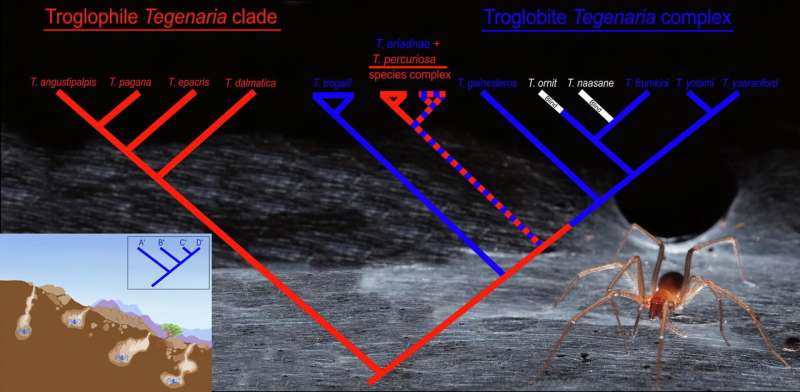This article has been reviewed according to Science X's editorial process and policies. Editors have highlighted the following attributes while ensuring the content's credibility:
fact-checked
peer-reviewed publication
trusted source
proofread
7 new spider species discovered in caves in Israel

In a new study conducted by researchers from the Hebrew University of Jerusalem and University of Madison-Wisconsin, seven new species of funnel web spiders (Agelenidae, Tegenaria), unique to caves in Israel, were discovered. These species join a large number of invertebrates recently found in Israeli caves that are new to science.
The study was recently published in the Molecular Phylogenetics and Evolution journal, and has extensive scientific implications for uncovering the evolution of speciation in caves and the historical, geographic and climatic processes that occurred in Israel.
Doctoral student Shlomi Aharon led the study under the guidance of Dr. Efrat Gavish-Regev, from the National Natural History Collections at Hebrew University and Professor Dror Hawlena from the Department of Ecology, Evolution and Behavior. The unique conditions in cave habitats, as well as the isolation from other habitats, lead to a process of convergent evolution, in which we observe the development of exceptional adaptations to life in the dark, such as blindness, loss of pigments and enlargement of sensory organs.
"In many cases, these adaptations will lead to the creation of new species, whose distribution is geographically limited in areas with unique ecological conditions, such as a single cave or a system of connected caves," explains Shlomi Aharon.
"In this study we sought to understand the evolutionary relationships between funnel web spiders (Agelenidae, Tegenaria) with normal eyes that are found at the entrance to the caves in Israel, and those that are deep in the cave and are pigmentless, eye-reduced and even completely blind."
After the spiders were collected by hand, the team of researchers conducted a series of microscopic examinations, recorded the morphology, and extracted DNA from each to compare them to sequences of known species of the same genus that exist in GenBank.
"Among the spiders we found, five were unique to different caves, and the two other species were found in several caves in the Galilee and in caves situated at the Ofra karst field, which is now under threat due to construction plans," explains Dr. Gavish-Regev.
"One of the surprising findings in the study show that the new species are evolutionarily closer to species from caves in Mediterranean areas in southern Europe, than to species living in close proximity to them at cave entrances in Israel."
Five of the new species described were eye-reduced, while the other two were completely blind. The researchers suggest that the new species developed adaptations to life in underground habitats and speciated in caves, after or simultaneously with the extinction of the ancestor species from which they evolved, which lived outside of caves and became extinct due to historical climate changes in the region.
"We are currently witnessing the effects of climate change on many habitats, which obliges us to consider, maintain and promote programs that include the preservation of underground habitats—many of which are at immediate risk," concludes Professor Hawlena. "We must protect Israel's unique nature, preserve its underground systems for the future and further explore the processes that created these systems in the country."
More information: Shlomi Aharon et al, In the land of the blind: exceptional subterranean speciation of cryptic troglobitic spiders of the genus Tegenaria (Araneae: Agelenidae) in Israel, Molecular Phylogenetics and Evolution (2023). DOI: 10.1016/j.ympev.2023.107705
Journal information: Molecular Phylogenetics and Evolution
Provided by Hebrew University of Jerusalem

















